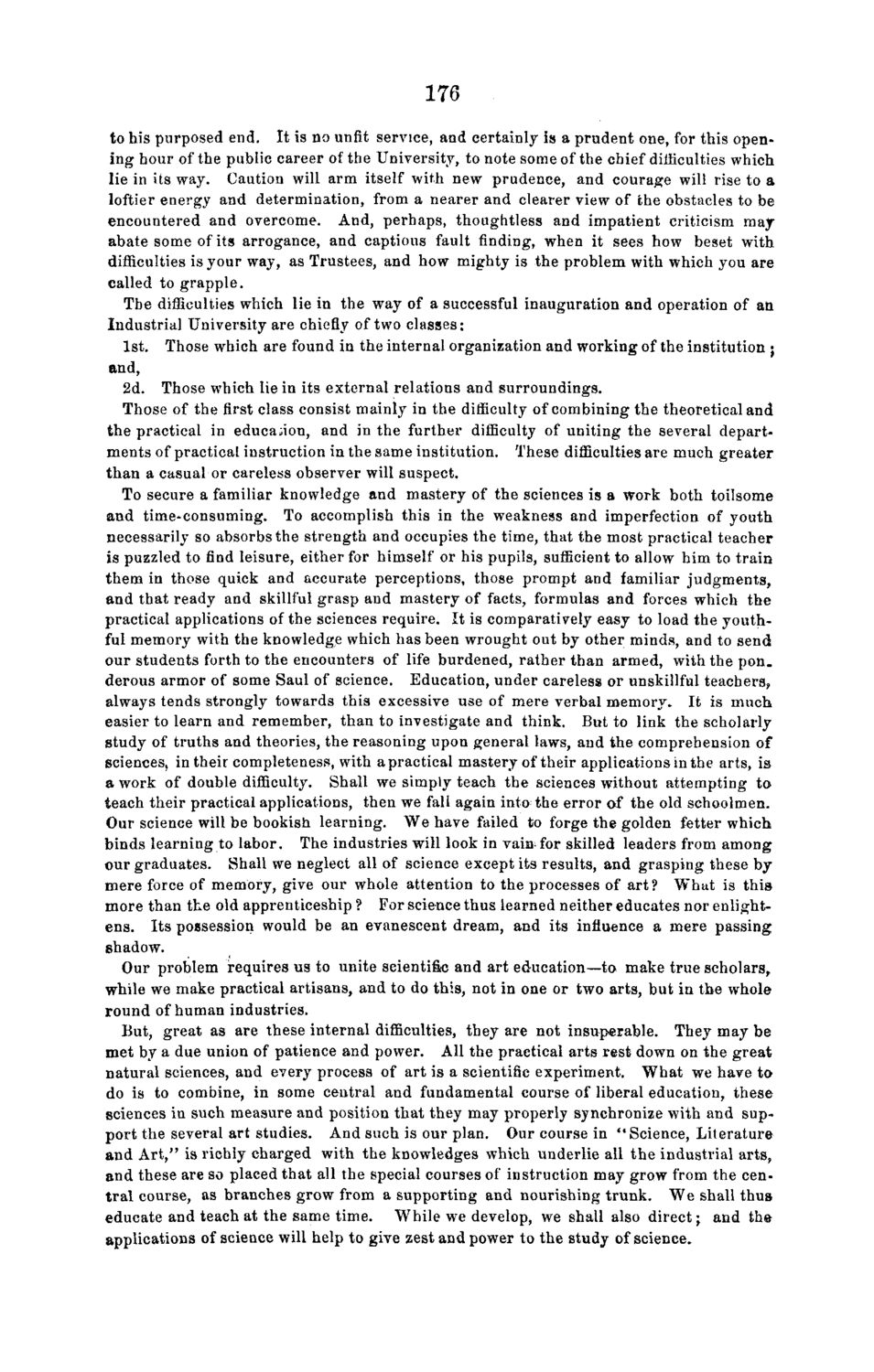| |
| |
Caption: Board of Trustees Minutes - 1868
This is a reduced-resolution page image for fast online browsing.

EXTRACTED TEXT FROM PAGE:
176 to his purposed end. It is no unfit service, and certainly is a prudent one, for this opening hour of the public career of the University, to note some of the chief difficulties which lie in its way. Caution will arm itself with new prudence, and courage will rise to a loftier energy and determination, from a nearer and clearer view of the obstacles to be encountered and overcome. And, perhaps, thoughtless and impatient criticism may abate some of its arrogance, and captious fault finding, when it sees how beset with difficulties is your way, as Trustees, and how mighty is the problem with which you are called to grapple. The difficulties which lie in the way of a successful inauguration and operation of an Industrial University are chiefly of two classes: 1st. Those which are found in the internal organization and working of the institution j and, 2d. Those which lie in its external relations and surroundings. Those of the first class consist mainly in the difficulty of combining the theoretical and the practical in education, and in the further difficulty of uniting the several departments of practical instruction in the same institution. These difficulties are much greater than a casual or careless observer will suspect. To secure a familiar knowledge and mastery of the sciences is a work both toilsome and time-consuming. To accomplish this in the weakness and imperfection of youth necessarily so absorbs the strength and occupies the time, that the most practical teacher is puzzled to find leisure, either for himself or his pupils, sufficient to allow him to train them in those quick and accurate perceptions, those prompt and familiar judgments, and that ready and skillful grasp and mastery of facts, formulas and forces which the practical applications of the sciences require. It is comparatively easy to load the youthful memory with the knowledge which has been wrought out by other minds, and to send our students forth to the encounters of life burdened, rather than armed, with the ponderous armor of some Saul of science. Education, under careless or unskillful teachers, always tends strongly towards this excessive use of mere verbal memory. It is much easier to learn and remember, than to investigate and think. But to link the scholarly study of truths and theories, the reasoning upon general laws, and the comprehension of sciences, in their completeness, with a practical mastery of their applications in the arts, is a work of double difficulty. Shall we simply teach the sciences without attempting to teach their practical applications, then we fall again into the error of the old schoolmen. Our science will be bookish learning. W e have failed to forge the golden fetter which binds learning to labor. The industries will look in vainfor skilled leaders from among our graduates. Shall we neglect all of science except its results, and grasping these by mere force of memory, give our whole attention to the processes of art? What is t h i s more than the old apprenticeship ? For science thus learned neither educates nor enlightens. Its possession would be an evanescent dream, and its influence a mere passing shadow. Our problem requires us to unite scientific and art education—to make true scholars, while we make practical artisans, and to do this, not in one or two arts, but in the whole round of human industries. But, great as are these internal difficulties, they are not insuperable. They may be met by a due union of patience and power. All the practical arts rest down on the great natural sciences, and every process of art is a scientific experiment. What we have t o do is to combine, in some central and fundamental course of liberal education, these sciences in such measure and position that they may properly synchronize with and support the several art studies. And such is our plan. Our course in '•Science, Literature and A r t , " is richly charged with the knowledges which underlie all t h e industrial arts, and these are so placed that all the special courses of instruction may grow from the cent r a l course, as branches grow from a supporting and nourishing trunk. W e shall thus educate and teach at the same time. While we develop, we shall also direct j and the applications of science will help to give zest and power to the study of science.
| |